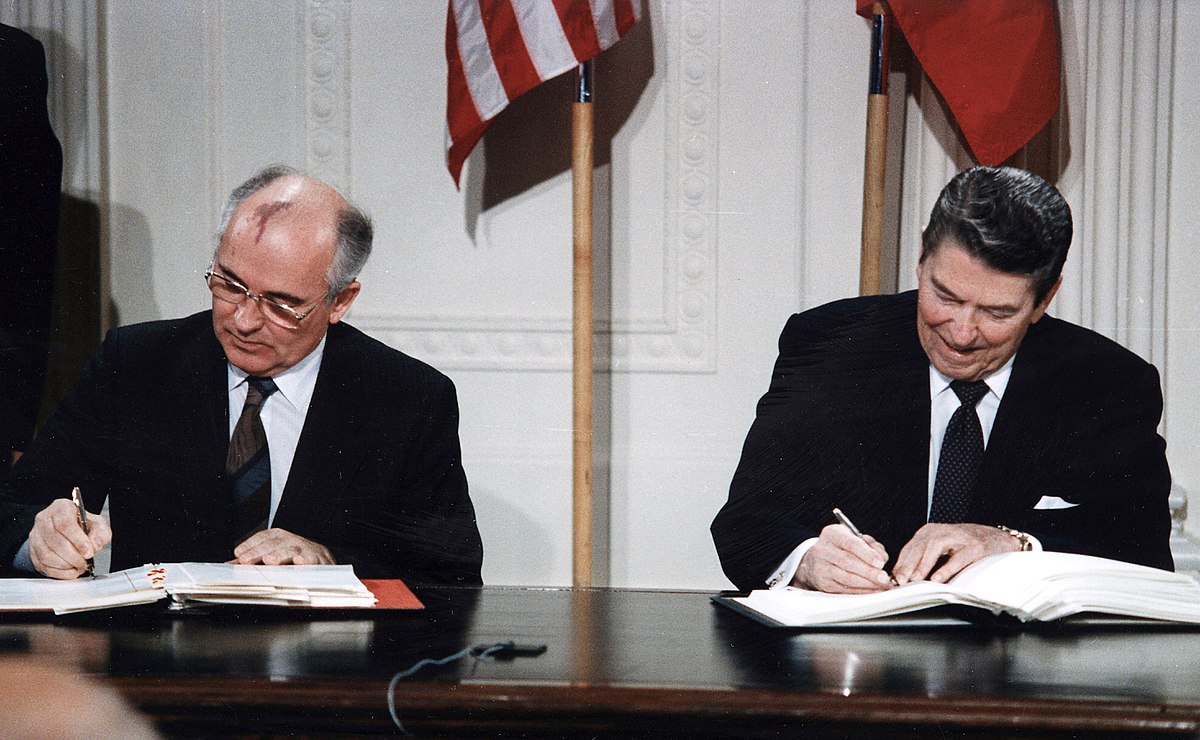With the formal announcement by the United States about the withdrawal from the INF treaty, Russia has followed the suit and declared the suspension of the treaty.

Intermediate-Range Nuclear Forces (INF) treaty
- It was crucial Cold War-era treaty banning development, testing and possession of short and medium range ground-launched nuclear missiles with range of 500-5,000 km.
- The treaty was signed in December 1987 between then US President Ronald Reagan and his USSR counterpart Mikhail Gorbachev.
- The treaty banned all nuclear and conventional missiles, as well as their launchers, with ranges of 500–1,000 km or (short-range) and 1,000–5,500 km (intermediate-range).
- This treaty was central to ending arms race between two superpowers during cold war and protected America’s NATO allies in Europe from Soviet missile attacks.
- It was designed to provide measure of some strategic stability on continent of Europe.
How the INF treaty aided in Diffusing Tensions?
- Due to the limited range, short flight times and unpredictable flight patterns, It was difficult to detect the short and medium ranges missiles.
- As a result, there was a threat of nuclear war in Europe which is sandwiched between Russia and US.
- The missiles were designed chiefly to fight a theatre nuclear war in Europe. It exacerbated crisis instability and increased the chances of an accidental nuclear war.
- Hence the destruction of these missiles under the provisions of the INF treaty was highly beneficial towards enhancing both regional and global security.
Reasons of US withdrawal
- US President Trump has alleged that Russia has violated treaty and has been violating it for many years.
- This violation comes after Russia’s alleged development and deployment of Novator 9M729 missile (also known as SSC-8), that could strike Europe at short notice.
- Accusations of Russia violating this treaty pre-dates Trump presidency and go back to 2008 during President Obama administration.
- Under former President Barack Obama raised issue of Russia testing ground-launched cruise missile with Russian President Vladimir Putin in 2014.
- But Russia had denied allegations and raised counter-allegations of the US installing missile defence systems in Europe.
- While two countries failed to find resolution using dispute resolution mechanism in treaty, US continued to remain party to treaty under pressure from its European allies.
Implications
- Both Russia and US would indulge in the development of these short and medium ranges missiles.
- There could be an arms race with EU joining the race as a third entity.
- Since these missiles are mobile, hard to detect, nuclear-capable and can reach European cities, they have hardly any warning time at all so they reduce the threshold for any potential use of nuclear weapons in a conflict. This would lead to instability and trust deficit.
History of INF Treaty:
- The deployment of IRBMs in Europe first became an arms-control issue in the late 1970s, when the Soviet Union began replacing its older single-warhead SS-4 and SS-5 IRBMs with newer and more accurate SS-20s, which could deliver three nuclear warheads apiece from a distance of 5,000 km. Mounted on mobile launchers based in the European part of the Soviet Union, the SS-20s could strike targets anywhere in western Europe in less than 10 minutes.
- One should note that under pressure from its western European allies in the North Atlantic Treaty Organization (NATO), the United States in 1979 committed itself to deploying two intermediate-range weapons systems of its own in western Europe: the Pershing II and the Tomahawk cruise missile. Mounted on mobile launchers, the Pershing II was an IRBM that could carry a single nuclear warhead a distance of about 2,000 km and strike within the vicinity of Moscow in less than 10 minutes.
- It is important to point out that the INF Treaty called for the progressive dismantling, over three years, of 2,619 missiles, about half of which were deployed at the time of signing. About two-thirds of the missiles affected were Soviet, and the rest were American.
- Further, each country was allowed to keep intact the warheads and guidance systems of the destroyed missiles. Also destroyed were missile launchers and various kinds of support equipment and structures.
- Teams of observers from both countries were given access to certain operating bases, support facilities, and elimination facilities in order to verify the withdrawal and destruction of the missile systems.